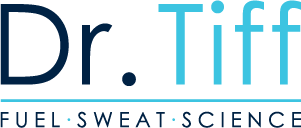How to Train Your Body to Burn More Fat
Do you want to become a better butter burner?
That may be a mouthful but it’s simple when it comes down to it. It means training your body to burn fat instead of sugar.
About 10 years ago, I started digging into this science. It was right around when Orange Theory was coming onto the scene.
For those that aren’t familiar, Orange Theory utilizes heart-rate/zone-based training. However, I started to realize that they weren’t giving people an accurate heart rate because they weren’t specifying individual aerobic and anaerobic thresholds.
Let’s learn why understanding your personal threshold is important for exercise and weight loss and how to maximize your workouts by doing lower intensity workouts and eating the right kind of fuel.
How to Burn Fat for Fuel
Fat metabolism happens at lower-level intensity (aerobic). Fat metabolism requires oxygen so if we start training at intensity levels that take us anaerobic (without oxygen), we start to shift out of fat metabolism and into carb utilization.
This isn’t good or bad. However, the bottom line is if we can teach our body to use more fat for fuel, we become more efficient in training at higher intensities without using stored glycogen.
Most of us have more stored energy in the source of fat than in the source of glycogen. Therefore, relying primarily on fat allows us to optimize our body composition and prolong the duration of our activity because we can sustain our energy levels longer.
Carbs
In the past, endurance athletes trained in a fasted state. The goal was to recruit more oxidative, fat-burning fibers. Because they didn’t have carbs as a readily available fuel source, this taught their body to use fat for fuel.
However, I don’t recommend you go low carb. There’s a better way to do this.
What I recommend is that you prioritize fuel that will give you slow-burning energy. This is found in the form of complex carbs like root vegetables, whole grains, and other slow-burning carbs as well as healthy fats. These foods won’t give an immediate insulin spike which creates an opportunity for the body to immediately want to use that as its primary fuel source.
A diet rich in moderate carbs and healthy fats coupled with training at lower levels of aerobic intensity builds up your base. It teaches your body to use fat as its primary fuel source. As a result, you build mitochondria density and oxidative capacity.
Try spending 80% of your time on base training. Then, you can get so much better with so much less in your high-intensity workouts. I’ve witnessed so many of my clients lose weight who were forced to slow down and do low-impact exercise.
In sum, think of your body as a hybrid vehicle. Carb utilization is the gas. It takes over when you push the acceleration and start and stop quickly.
On the other hand, when you drive slow and steady, you go into electric mode. If you can stay electric, conserve, and save up energy, then when you need it, you can go into gas mode and have enough stored up to use.
If you want to learn more about fat metabolism, check out Episode 020: Become a Better Butter (FAT!) Burner.
